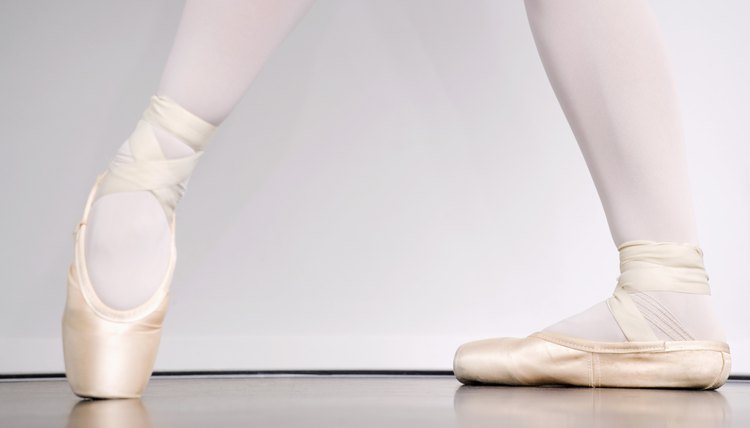What Leg Muscles Are Engaged During a Ballet Pirouette?

The classic ballet move, the pirouette, is a complete 360-degree turn performed on one leg. In a ballet, it is usually done more than one time, in a twirling motion. Leg muscles used in a pirouette are the calves, hamstrings and quadriceps. The surrounding muscles of the knees play a crucial role in balance and rotation during a pirouette. The inner and outer thigh muscles help the leg remain straight and assist in balancing the body so it does not lean left or right as you move through the spin.
Strong Calves and Flexible Ankles

Getty Images/Lifesize/Getty Images
Ballet requires strong ankles. It is important to strengthen this area so you are not wobbly in your turns. Dancers master the plié and relevé before attempting a pirouette. A plié is a fundamental ballet movement done with both of your knees bent in an opposite direction while your back is straight. This can be done with your heels together, known as first position, or with your legs hip-distance apart, known as second position. A relevé is basically rising to the balls of your feet (demi-pointe) or to the tops of your toes (full pointe). Both of these basic ballet moves strengthen the ankles and calf muscles.
Quadriceps
Dancers are drilled daily in straight line leg work when they are learning ballet movements. Ballerinas work on achieving lean, strong and flexible quadriceps through moves like arabesque, grand pliés and frappés. Through this work, ballet dancers develop elongated muscles through the legs, which help support them in moves like a pirouette. In a pirouette, it is important to have strong quadriceps and sartorius adductor muscles (inner thigh) so your standing leg can support the twirl.
Hamstrings

Getty Images/Lifesize/Getty Images
Tight hamstrings can result in a pronated pirouette. In ballet, the hamstrings work in conjunction with the knees and iliopsoas muscles to create straight lines like in arabesque, as well as assist with hip turnout. All ballet moves are performed with turned-out hips, which requires a lateral rotation of the legs. Make sure your hamstrings are stretched before attempting a pirouette. Classic stretches such as forward bends and moves done on a ballet barre are best to make sure this area is flexible enough for a pirouette.
Hips and Knees
For a dancer, the most important parts of the body to strengthen in order to execute a proper pirouette are the hips and knees. Strength in these areas ensures you have enough strength to execute the 360-degree turn. The gluteal muscles, adductor muscles, iliopsoas group and lateral rotators, in conjunction with the patellar tendon, assist in holding a ballerina's body upright. It is critical to have extended range of motion in these areas of your body so that you are not injured in performing this ballet move.
References
Resources
Writer Bio
L.P. Biersdorfer has been writing about sports, travel and pop culture for more than 20 years. She has been published in "CosmoGirl," "Racing Milestones," "Florida Magazine," "New York Moves," "The Financial Playbook" and Motorsport.com. Biersdorfer also contributed to the 2004, 2005 and Silver Screen editions of "Trivial Pursuit."
